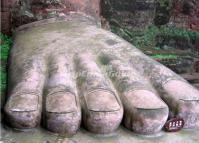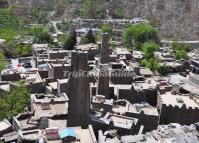Achang Ethnic Group
Achang ethnic group is one of the ancient groups in China. They mainly live in Yunnan Province. Achang people are mainly engaged in agriculture and famous for their handicraft, especially known for forging revolving knife.
Population
39,555 (2010)
Main Areas Inhabited by Achang
Longchuan County, Lianghe County, Nangsong County (Dehong Prefecture of Yunnan); Caojian and Jiuzhou (Yunlong Couty of Dali Bai Autonomous Prefecture); and some areas in Tengchong Couty and Longling County (Baoshan of Yunnan).
Language
Achangs speak a language belonging to the Tibetan-Myanmese language family of the Chinese-Tibetan system. Most Achangs also can speak Chinese and the language of Dais. Their written language is Chinese.
History
The ancestors of the Achang were some of the first inhabitants of the province of Yunnan. Their ancestors lived near the Lancang river and during the 12th century they began to emigrate towards the border the west of the river. By the 13th century, some of them settled down in the area of Longchuan, whereas others settled around Lianghe. During the Ming and Qing dynasties they were governed by local village heads.
Culture and Art
Achangs treasure their oral culture of ballads, stories and folk tales. Singing alternating duets is a favorite evening recreation of young men and women. Musical instruments used by Achangs include the bamboo qin (a stringed plucked instrument), the bamboo flute, the gourd-shaped sheng (a wind instrument), the sanxian (a three-stringed plucked instrument), the elephant-leg drum and the gong. Drum and monkey dances are among the most popular. Handicrafts include embroidery, lacquering, dyeing, weaving, engraving and silverware making and are known for their elaborate patterns and detail. Achang engraving is extraordinary and can best be seen on furniture, buildings and Buddhist shrines, on which workers have etched vivid forms of animals and plants.
Religion
Most Achangs on the Fusa plain believe in Hinayana, a branch of Buddhism. There are regularly religious festivals and activities every year, such as "into the hollow", "out of the hollow", "white wood burning", etc. Besides, the Achang people generally practice ancestor worship, because of influenced by the Han nationality.
Clothing
Achang men tend to wear blue, white or black jackets which button down the front; although on the Lasa plain many men wear jackets with buttons toward the left side. Achang women like to wear silver objects on festive occasions. Their clothes vary somewhat depending on where they live, but in general married women wear skirts and jackets with tight sleeves and wrap their heads with black or blue cloth that may go as high as three decimeters. Unmarried women wear trousers and tie their pigtails on top of their heads.
FoodAchangs eat rice as their staple and prefer sour dishes. Although the habit is disappearing, young men and women used to chew areca, blackening their teeth.
Building
They live in courtyard houses of brick or stone with wood beam supports. Achang villages are connected by gravel paths or roads paved with stone slabs.
Marriage
The basic unit of the Achang society is the patriarchal, monogamous family. Young men and women are free to choose their spouses. Courting rituals are quite specific. When dusk falls, young men go to bamboo groves near the homes of the young women they desire and play the sheng to win their favor. In some places, groups of young men and women gather around a bonfire, where couples flirt by singing alternate verses. This can go on until dawn. Before 1949, marriages were arranged by parents, which often led to forced marriage and misery for unlucky young lovers. The Achangs have a strict incest taboo: people with the same surname do not marry each other. But intermarriage with Hans and Dais has always been permitted.
Obsequies
Achangs generally bury their dead. In Buddhist areas, funerals are scheduled on holy days and follow the chanting of scripture by monks. One monk leads the funeral procession. As he walks, he holds a long strand of white cloth tied to the coffin, as if he were guiding the dead into the "Heavenly Kingdom." The coffin is to be carried above the heads of the close relatives of the dead, figuratively providing the deceased with a "bridge" to cross the river to the netherworld. The dead are buried without their metal ornaments; even the gold coatings on false teeth must be removed to make sure nothing will contaminate their reincarnation. Those who die of infectious diseases or childbirth are cremated.
Past Socio-economic Conditions
Before 1949 Achangs in the Lianghe area lived within a familial organization called the "Jiahui" (family meeting). Similar to the patriarchal clan system, the Jiahui had written family rules and chose patriarchs to maintain the feudal order of exploitation. Regarded as inferiors to the men in the Jiahui, women had few rights. They had no right of inheritance. After 1949 these practices were gradually eliminated.
The Achangs' ancestors once lived in the Jinsha, Lancang and Nujiang river valleys in northwestern Yunnan. Some of them moved west of the Nujiang River where they gradually evolved from hunters to farmers. According to legends, Achang forbears in those days lived in a matriarchal society with women having a dominant familial and social position and lovers living in group marriages.
During the Tang and Song dynasties (618-1279), the Achang area was controlled by Yunnan's Nanzhao and Dali principalities. During the Ming and Qing dynasties (1368-1911), the Achangs were ruled by Achang hereditary chiefs appointed by -- and accountable to -- the imperial court. After the Revolution of 1911, warlords in Yunnan established an administrative bureau in the Achang area, installing the Bao-Jia system (an administrative system organized on the basis of households, each Jia being made up of 10 households, and each Bao of 10 Jia, by which the warlords enforced their rule at the primary level), oppressing and exploiting the Achang people in collaboration with local chiefs.
Before 1949, feudalism was the dominant economic form in the areas in which the Achangs lived. Farming was done according to the landlord system. Dai chiefs were the feudal lords; most landlords were Hans. Achang landlords were few.
Where they ruled, chiefs owned all the land. Aside from collecting taxes to enrich themselves, they used their political privileges to extort "gifts" from peasants on such occasions as holidays, weddings and funerals. The ruling classes, including Achang landlords, prospered through usury and the exploitation of labor.
Under the rule of chiefs, the Achang social structure was destroyed. Achangs were organized into the "gang" (township) and the "zuo" (district), through which the chiefs ruled them and levied tax upon them. "Official tax," "tax on opium," "tax on land" -- these and other taxes and levies squeezed the people, draining them of whatever comforts they could accumulate. In addition, many Achang villages were burdened with a fixed amount of required, unpaid labor.
Post-liberation Life
Liberation came for the Achangs in early 1950. Two years later, an Achang autonomous district was established in Longchuan County's Fusa area, where the Achangs were concentrated. This was followed by the establishment of three more Achang autonomous districts in the counties of Luxi and Lianghe in 1953 and 1954. When the Dehong Dai-Jingpo Autonomous Prefecture was created, the Achangs were amply represented in the prefectural people's congress.
Beginning in the autumn of 1955, a gradual land reform abolished feudal land ownership in the Achang area. Also abolished were feudal privileges, taxes and usury. Farmers were organized into cooperatives in 1958.
Achangs are famous for their rice cultivation. Before 1950, Achangs were kept so poor by the feudal system that they could not afford to eat rice. But since liberation, Achangs have been able to build irrigation systems that have transformed arid land into fertile paddy fields, ensuring steady rice harvests. They also have built small hydroelectric stations, and have bought farm machinery such as tractors, rice mills, diesel engines, threshers and winnowers.
Industry
Local industries, built up from nothing, are centered on Lianghe. They now include ironwork, oil pressing, dyeing, and farm tool, soap and rosin production. In Lhasa, an ironworks produces water-powered fire blowers, replacing the manual ones that were in common use.
Education
Development of education has been a priority. Before 1950, there was only one school, in Lasa, and that one mainly enrolled the children of chiefs. Today, however, several dozens of primary and middle schools have been set up and almost all Achang children are at schools.
Medical Treatment
In those areas, epidemics used to run rampant. After 1950, epidemic prevention stations and clinics have been established, and medical workers of Achang origin have been trained. Epidemics such as the plague, cholera and typhoid fever have been eliminated.
Festivals
The representative festivals of Achangs are Woluo Festival (January 4 in lunar calendar), Torch Festival (June 24 in lunar calendar) and Water-sprinkling Festival (The seventh day after the tomb-sweeping day).
Taboos
1. Domestic and other animals are forbidden to be killed or harmed on the first day of the lunar New Year's Day
2. Males of other families are forbidden to visit within seven days after a female has given birth;
3. Standing and sitting on the threshold or cutting the threshold with a sword is forbidden, because they think it stands for the prosperity of the family and the abundant generations of the family;
4. Photos or hair burning is forbidden, because they think if it is burnt, the person will be seriously ill or mad;
5. A male and a female with the same family name are forbidden to get married.

















